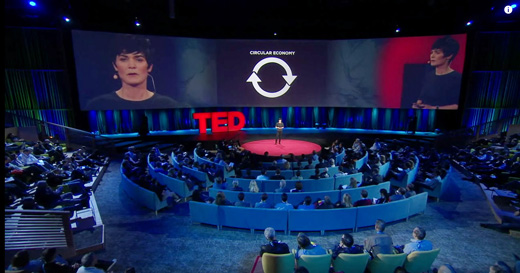Reaching the circular economy: ‘Anything and everything is possible’
This was the sentiment expressed by Dame Ellen MacArthur at her recent TED talk in Vancouver. MacArthur began by describing her long-held dream of sailing around the world, and how she made it happen. In 2005, aged 29, she broke the world record for the fastest solo circumnavigation of the globe. While she was on her amazing journey, thousands of miles from civilisation, she made a stark realisation: just as she had packed all the food, fuel and clothes she needed for the duration of the trip, so Earth’s natural resources are also finite. “What we have out there is all we have – there is no more,” she says.
From then on, she rapidly began to connect the dots – the global economy was no different to her solo trip in this sense – it’s based on a finite supply of natural materials. “It was like seeing something unexpected under stone – I could choose to ignore it and replace the stone, or not…” says MacArthur. She chose the latter, and began a new journey of learning, speaking to scientists, economists and businesses leaders to understand how our global economy works.
With our stocks of fossil fuels depleting and just decades left until we run out of materials like copper, zinc and silver (according to current projections), it was clear that something had to be done. A rapidly increasing global population creating a steady demand for more ‘stuff’, coupled with a ‘throwaway’ consumer culture, has led to a frenzied consumption of natural resources, and mountains of waste.
Not only this – the precarious state of natural resources puts businesses under pressure too – raw material price volatility poses significant risks for the world’s manufacturers.
MacArthur realised the system was fundamentally flawed – that it would buckle and break if we kept up the ‘take, make, waste’ model. Through her research and conversations with experts, she realised that a circular system – whereby all materials are used in a restorative way that mimics nature – would ultimately allow humanity to thrive in the long term.
She established the Ellen MacArthur Foundation in 2010 and hasn’t looked back. Through the Foundation, many experts have collaborated to understand best practices – industrial symbiosis, Cradle to Cradle design, biomimicry, ‘access over ownership’ – and how they can contribute to a regenerative economy, a world without waste.
Now, MacArthur concludes, they have a plan. The circular economy can be scaled up – we can decouple growth from resource restraints – with real commitment from government, businesses and society. Young people have been truly inspired by the circular economy and the opportunities it brings. Their creativity and knowledge will be vital in building a new economic system.

